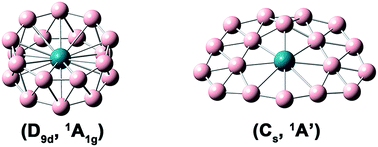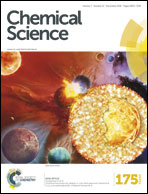Competition between drum and quasi-planar structures in RhB18−: motifs for metallo-boronanotubes and metallo-borophenes†
Abstract
Metal-doped boron clusters provide new opportunities to design nanoclusters with interesting structures and bonding. A cobalt-doped boron cluster, CoB18−, has been observed recently to be planar and can be viewed as a motif for metallo-borophenes, whereas the D9d drum isomer as a motif for metallo-boronanotubes is found to be much higher in energy. Hence, whether larger doped boron drums are possible is still an open question. Here we report that for RhB18− the drum and quasi-planar structures become much closer in energy and co-exist experimentally, revealing a competition between the metallo-boronanotube and metallo-borophene structures. Photoelectron spectroscopy of RhB18− shows a complicated spectral pattern, suggesting the presence of two isomers. Quantum chemistry studies indicate that the D9d drum isomer and a quasi-planar isomer (Cs) compete for the global minimum. The enhanced stability of the drum isomer in RhB18− is due to the less contracted Rh 4d orbitals, which can have favorable interactions with the B18 drum motif. Chemical bonding analyses show that the quasi-planar isomer of RhB18− is aromatic with 10 π electrons, whereas the observed RhB18− drum cluster sets a new record for coordination number of eighteen among metal complexes. The current finding shows that the size of the boron drum can be tuned by appropriate metal dopants, suggesting that even larger boron drums with 5d, 6d transition metal, lanthanide or actinide metal atoms are possible.


 Please wait while we load your content...
Please wait while we load your content...